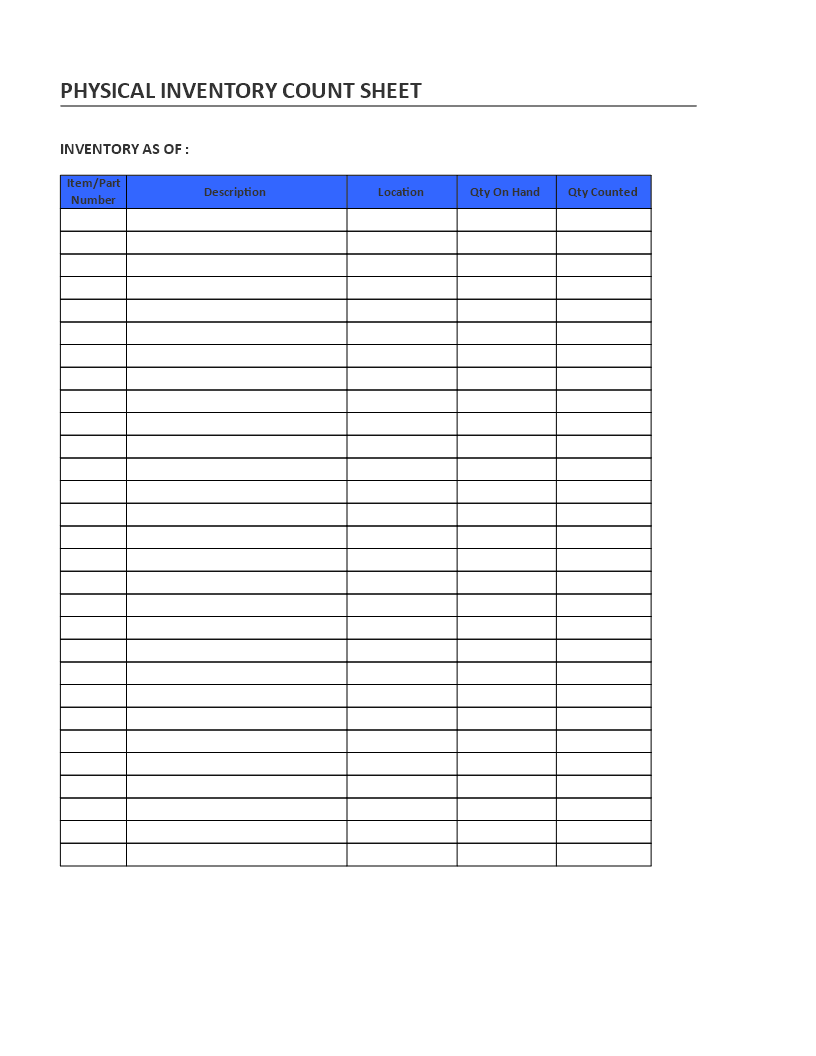Inventory Counting Sheet Example
Save, fill-In The Blanks, Print, Done!

Download Inventory Counting Sheet Example
Microsoft Word (.doc)Or select the format you want and we convert it for you for free:
- This Document Has Been Certified by a Professional
- 100% customizable
- This is a digital download (51.5 kB)
- Language: English
- We recommend downloading this file onto your computer.
Looking for a template for an inventory counting sheet? How should inventory count sheets be filled out? We have a sample of inventory counting sheet templates to suit your specific requirements. Download our template which is easy to use and can be customized to fit your business's needs.
An inventory counting sheet, also known as an inventory count sheet or inventory checklist, is a document used in inventory management to record the physical count of items or products in a stockroom, warehouse, store, or any other location where inventory is stored. The purpose of an inventory counting sheet is to track and verify the actual quantity of items on hand, ensuring accuracy in the inventory records.
Here are the typical components and information found on an inventory counting sheet:
- Date: The date on which the physical inventory count is being conducted.
- Location: The specific location or area where the inventory count is taking place. This could be a warehouse section, storage room, or specific shelf or bin.
- Item Information:
- Item Name or Description: A brief description or name of the item being counted.
- Item Code or SKU: A unique identifier for the item, which is often used in inventory systems.
- Unit of Measurement: The unit in which the item is counted (e.g., pieces, boxes, pounds).
- Starting Inventory: The initial quantity of the item as recorded in the inventory system before the physical count begins. This information helps identify discrepancies.
- Physical Count: The actual quantity of the item found during the physical inventory count. This is often recorded by hand tallying or using electronic devices like barcode scanners.
- Variance: The difference between the starting inventory and the physical count. Positive variances indicate that there are more items in stock than recorded, while negative variances mean there are fewer items.
- Reason for Discrepancy: A brief note explaining the reason for any discrepancies found during the count. This could include issues like damaged items, theft, or recording errors.
- Final Count: The adjusted quantity of the item after accounting for any discrepancies. This is often calculated as the starting inventory plus or minus the variance.
- Signature: The signature of the person responsible for conducting the inventory count. This provides accountability and verification of the count.
- Supervisor's Signature: In some cases, a supervisor or manager may also need to sign off on the inventory count sheet to confirm its accuracy.
Inventory counting sheets are essential tools for maintaining accurate inventory records and ensuring that physical inventory levels match what is recorded in the organization's inventory management system. These sheets are typically used during regular inventory audits, cycle counts, or year-end reconciliations to identify discrepancies, address issues, and maintain inventory accuracy.
DISCLAIMER
Nothing on this site shall be considered legal advice and no attorney-client relationship is established.
Leave a Reply. If you have any questions or remarks, feel free to post them below.
Related templates
Latest templates
Latest topics
- GDPR Compliance Templates
What do you need to become GDPR compliant? Are you looking for useful GDPR document templates to make you compliant? All these compliance documents will be available to download instantly... - Daily Report Sheets For Preschool
How do you create a kindergarten schedule or write a daily report for a preschool? Check out these preschool templates here. - Celcius To Farenheit Chart
How to Download our temperature Celsius to Fahrenheit conversion charts and streamline your temperature calculations and conversions here. - Play Money Template
Where to download cool Play Money templates? Download below our printable and customizable Play Money templates for fun or with space for your face template now! - Flyer Template
Creating strong marketing materials that support your marketing strategy, such as flyers or online promotion (banners, ads) are an important part of growing a successful business!
cheese

